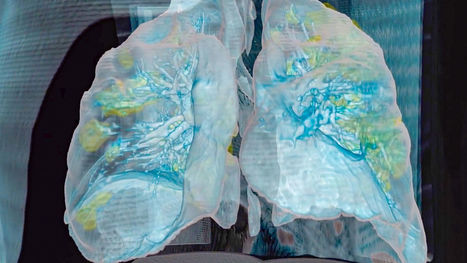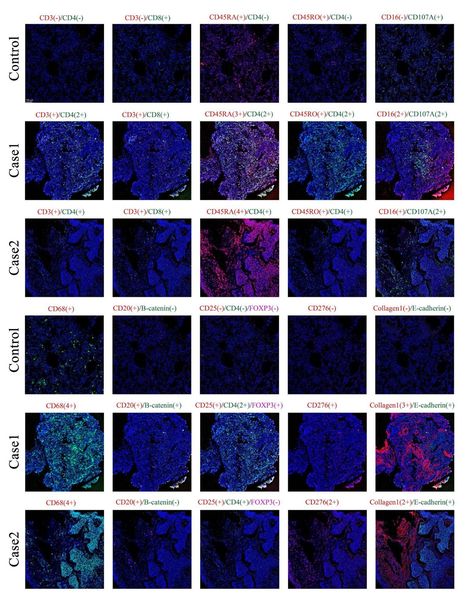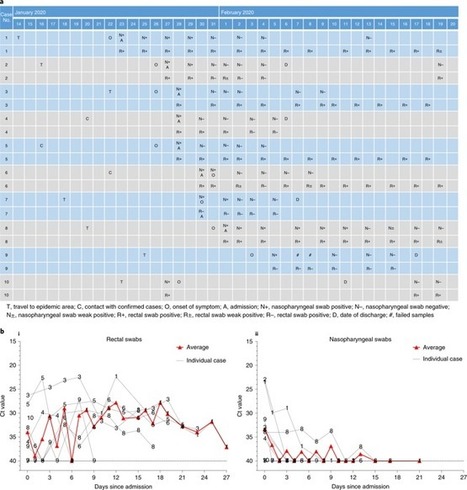 Your new post is loading...
 Your new post is loading...

|
Rescooped by
Gilbert C FAURE
from Virus World
July 25, 2020 2:54 PM
|
Early and accurate detection is critical for preventing the spread of COVID-19 and providing appropriate care for patients. Nasopharyngeal (NP) swabs, which require inserting a long shaft into the nasal cavity to collect a sample from the back of the nose and throat, are currently the gold standard for collecting a specimen for diagnosis. But the procedure is technically challenging, often uncomfortable for patients and requires personal protective equipment that may be in short supply. Other approaches to collecting specimens—including from an oropharyngeal swab and sputum—have been tested in small studies, but there is uncertainty about which method is best for detecting the virus. In a new study published in EBioMedicine, investigators from Brigham and Women's Hospital conducted a systematic review and meta-analysis, analyzing data from more than 3,000 specimens to compare the three approaches. The team found that sputum testing detected the RNA of the virus that causes COVID-19 at significantly higher rates while oropharyngeal swab testing had lower rates. Regardless of the collection method, the earlier samples were collected after symptoms began, the higher the detection rate. "The accurate diagnosis of COVID-19 has implications for health care, return-to-work, infection control and public health," said corresponding author Jonathan Li, MD, a faculty member in the Division of Infectious Diseases at the Brigham. "Our gold standard in and out of the hospital is the nasopharyngeal swab, but there's a lot of confusion about which sampling modality is best and most sensitive. Our study shows that sputum testing resulted in significantly higher rates of SARS-CoV-2 detection and supports the use of this type of testing as a valuable method for the diagnosis and monitoring of COVID-19 patients." Li and his colleagues scoured the literature—both preprints and published papers—for studies that assessed at least two respiratory sampling sites using an NP swab, oropharyngeal swab or sputum. From more than 1,000 studies, they identified 11 that met their criteria. These studies included results from a total of 3,442 respiratory tract specimens. The team examined how often each collection method produced a positive result. For NP swabs, the rate was 54 percent; for oropharyngeal swabs, 43 percent; for sputum, 71 percent. The rate of viral detection was significantly higher in sputum than either oropharyngeal swabs or NP swabs. Detection rates were highest within one week of symptom onset for all three tests. Study Published in EbioMedicine (July 18, 2020): https://doi.org/10.1016/j.ebiom.2020.102903
Via Juan Lama

|
Scooped by
Gilbert C FAURE
July 10, 2020 11:02 AM
|
Coronavirus disease 2019 (COVID-19) first emerged in late 2019 in China.At the time of writing, its causative agent SARS-CoV-2 has spread worldwide i…...

|
Scooped by
Gilbert C FAURE
June 5, 2020 9:36 AM
|
A new study has revealed that SARS-CoV-2 infects the nasal cavity to the greatest degree and infects and replicates progressively less well in cells lower in the respiratory tract. The work, including the development of key laboratory tools, has been accepted by Cell.

|
Scooped by
Gilbert C FAURE
May 25, 2020 6:49 AM
|
Abstract Background Progressive respiratory failure is the primary cause of death in the coronavirus disease 2019 (Covid-19) pandemic. Despite widespread interest in the pathophysiology of th

|
Scooped by
Gilbert C FAURE
May 17, 2020 11:40 AM
|

|
Scooped by
Gilbert C FAURE
May 5, 2020 2:56 AM
|
Researchers from the Hubrecht Institute in Utrecht, Erasmus MC University Medical Center Rotterdam, and Maastricht University in the Netherlands have found that the coronavirus SARS-CoV-2, which causes COVID-19, can infect cells of the intestine and multiply there. Using state-of-the-art cell cultur

|
Scooped by
Gilbert C FAURE
May 5, 2020 2:19 AM
|

|
Scooped by
Gilbert C FAURE
May 2, 2020 9:21 AM
|
Investigators in a brief communication in Nature Medicine utilised the Covid19 cell atlas database to identify gene expression of the SARS-CoV-2 entry receptor ACE2 and other genes potentially associated with pathogenesis using known single-cell RNA sequencing datasets.

|
Scooped by
Gilbert C FAURE
April 28, 2020 1:48 PM
|
Is SARS-CoV-2 Also an Enteric Pathogen with Potential Fecal-Oral Transmission: A COVID-19 Virological and Clinical Review

|
Rescooped by
Gilbert C FAURE
from Virus World
April 18, 2020 2:45 PM
|
The lungs are ground zero for COVID-19, but blood clots may play a surprisingly big role in severe illness. On rounds in a 20-bed intensive care unit (ICU) one recent day, physician Joshua Denson assessed two patients with seizures, many with respiratory failure and others whose kidneys were on a dangerous downhill slide. Days earlier, his rounds had been interrupted as his team tried, and failed, to resuscitate a young woman whose heart had stopped. All shared one thing, says Denson, a pulmonary and critical care physician at the Tulane University School of Medicine. “They are all COVID positive.” As the number of confirmed cases of COVID-19 surges past 2.2 million globally and deaths surpass 150,000, clinicians and pathologists are struggling to understand the damage wrought by the coronavirus as it tears through the body. They are realizing that although the lungs are ground zero, its reach can extend to many organs including the heart and blood vessels, kidneys, gut, and brain. “[The disease] can attack almost anything in the body with devastating consequences,” says cardiologist Harlan Krumholz of Yale University and Yale-New Haven Hospital, who is leading multiple efforts to gather clinical data on COVID-19. “Its ferocity is breathtaking and humbling.” Understanding the rampage could help the doctors on the front lines treat the fraction of infected people who become desperately and sometimes mysteriously ill. Does a dangerous, newly observed tendency to blood clotting transform some mild cases into life-threatening emergencies? Is an overzealous immune response behind the worst cases, suggesting treatment with immune-suppressing drugs could help? What explains the startlingly low blood oxygen that some physicians are reporting in patients who nonetheless are not gasping for breath? “Taking a systems approach may be beneficial as we start thinking about therapies,” says Nilam Mangalmurti, a pulmonary intensivist at the Hospital of the University of Pennsylvania (HUP)....
Via Juan Lama

|
Scooped by
Gilbert C FAURE
April 15, 2020 8:45 AM
|
Background: A previous report of lung biopsies from a patient with coronavirus disease 2019 (COVID-19) and acute respiratory distress syndrome (ARDS) identified mononuclear cell infiltration but not the type of mononuclear cells ( 1 ).

|
Scooped by
Gilbert C FAURE
April 10, 2020 2:18 PM
|
Prodigious virus numbers in Covid-19 linked to contagion, say experts...

|
Scooped by
Gilbert C FAURE
April 1, 2020 11:50 AM
|
We report epidemiological and clinical investigations on ten pediatric SARS-CoV-2 infection cases confirmed by real-time reverse transcription PCR assay of SARS-CoV-2 RNA. Symptoms in these cases were nonspecific and no children required respiratory support or intensive care. Chest X-rays lacked definite signs of pneumonia, a defining feature of the infection in adult cases. Notably, eight children persistently tested positive on rectal swabs even after nasopharyngeal testing was negative, raising the possibility of fecal–oral transmission. Children infected with the COVID-19 outbreak coronavirus, SARS-CoV-2, show mild symptoms but prolonged shedding of viral RNA in feces, suggesting that the fecal–oral route might play a role in virus transmission.
|

|
Scooped by
Gilbert C FAURE
July 23, 2020 6:56 AM
|
L’entreprise britannique Synairgen déclare avoir conçu un traitement permettant de réduire largement les risques de mortalité en cas de contamination par le SARS-CoV-2. La formule, baptisée SNG001, affiche des résultats significatifs ; ceux-ci n’ont toutefois pas encore été validés par un comité...

|
Scooped by
Gilbert C FAURE
June 25, 2020 2:54 AM
|
L’infection par le SARS-CoV-2 s’accompagne parfois d’une perte d’odorat. La bonne nouvelle ? Celui-ci devrait très probablement être de retour une fois l’infection terminée. Plus ou moins vite.

|
Scooped by
Gilbert C FAURE
June 1, 2020 1:41 AM
|
virus in feces and on surfaces

|
Scooped by
Gilbert C FAURE
May 21, 2020 4:26 AM
|
Credit: Toshio Hirano and Masaaki Murakami. Immunity.April 22, 2020 Research into how the SARS-CoV-2 virus induces death is suggesting...

|
Scooped by
Gilbert C FAURE
May 8, 2020 11:44 AM
|
Lung and coagulopathy and macrophages

|
Scooped by
Gilbert C FAURE
May 5, 2020 2:31 AM
|
1. In this case series, imaging mass cytometry revealed aberrant CD45RA+ T cells in the lung tissue of patients with COVID-19. 2. The identities of infiltrated cells were determined to be CD4 and CD8

|
Scooped by
Gilbert C FAURE
May 4, 2020 4:38 AM
|
See Trending Virtual Issue...

|
Scooped by
Gilbert C FAURE
May 1, 2020 1:46 PM
|

|
Scooped by
Gilbert C FAURE
April 23, 2020 2:46 AM
|
medRxiv - The Preprint Server for Health Sciences

|
Scooped by
Gilbert C FAURE
April 15, 2020 1:40 PM
|
We report temporal patterns of viral shedding in 94 patients with laboratory-confirmed COVID-19 and modeled COVID-19 infectiousness profiles from a separate sample of 77 infector–infectee transmission pairs. We observed the highest viral load in throat swabs at the time of symptom onset, and inferred that infectiousness peaked on or before symptom onset. We estimated that 44% (95% confidence interval, 25–69%) of secondary cases were infected during the index cases’ presymptomatic stage, in settings with substantial household clustering, active case finding and quarantine outside the home. Disease control measures should be adjusted to account for probable substantial presymptomatic transmission. Presymptomatic transmission of SARS-CoV-2 is estimated to account for a substantial proportion of COVID-19 cases.

|
Scooped by
Gilbert C FAURE
April 11, 2020 2:00 PM
|
AbstractObjectives. To report the methods and findings of two complete autopsies of severe acute respiratory syndrome coronavirus 2 (SARS-CoV-2) positive indiv

|
Scooped by
Gilbert C FAURE
April 2, 2020 3:38 AM
|
Background: The outbreak of coronavirus disease 2019 (COVID-19) has become a global public health problem. In the absence of a specific therapy or vaccine, timely diagnosis and the establishment of a sufficient isolation period for infected individuals are critical to containment efforts. Real-time quantitative fluorescence polymerase chain reactio
|



 Your new post is loading...
Your new post is loading...






















